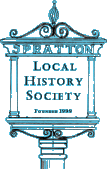SEARCH PHOTOGRAPHIC ARCHIVE


Circa 1850 - Spratton Hall from a George Clarke drawing
The house was built by Mr Francis Beynon, probably in 1760 (although 1773 is marked on the rainwater leads), using white limestone from Kingsthorpe quarry and roofed with slates.
His interest in Spratton, however, started earlier in 1743 with a ‘site assembly’ of the land that ultimately made up the Spratton Hall plot. He inherited the Advowson in 1762 (through marriage to Elizabeth Okell), and as a consequence was one of the largest beneficiaries of the Enclosure Act award of 1766.
The estate, originally some 300 acres, passed to daughter Elizabeth and had increased to 520 acres by the time that it was inherited by her son, Francis Beynon Hackett. However, he never lived in Spratton, residing at one of the family seats, Moor Hall in Sutton Coldfield. Despite three significant estates (he also owned Moxhull Hall in Warwickshire), he had difficulty in making ends meet (he had 10 children), and raised mortgages on the Spratton and Moor Hall estates from 1817 onwards. He put the Estate up for sale in 1826, but, based on subsequent mortgage renewals, none of the Lots sold. Apart from the acreage, the estate included others substantial houses – the White Horse Coaching Inn, The Manor House in Manor Road, the farm at the end of Yew Tree Lane and The Walk, and a farmhouse associated with Spratton Hall directly to the south of Home Farm (but not Home Farm).
Robert Ramsden (with his wife Frances and their six children) came to Spratton Hall in 1818 as a tenant with some 40 acres. He had bought the Hall and this land by 1821. They took a great interest in education and endowed a Free School for Girls and Boys, and also an Infants School. Mrs Ramsden and her sister ran the Spratton Ladies’ Bible Association.
General Whichcote, who fought at the battle of Waterloo, lived at Spratton Hall in the 1840s. He attended the famous officers’ ball given by the Duchess of Richmond in Paris in the night before the battle. When he died in 1891, having left Spratton long before, some villagers claimed to remember him, ‘a fine portly figure’ walking around the village with a basket on his arm full of good things for the sick. He would visit the poor and the elderly to read to them and people remembered his ‘frank and courteous bearing and his kind and unfailing liberality’.
From 1849 until he died (aged 66) in 1877 Captain Mildmay Clerk lived here. The estate with 108 acres was put up for sale by auction on 6 October 1877 (Northampton Mercury 8 September 1877), but appears not to have sold as it was sold to Captain Theophilus Gist in 1879. He gave notice to the Bosworths who were farming the Spratton Hall land, and is shown in Kelly’s Directory of 1884 as a grazier. William Macnaghton, the 5th Baron Erskine (born 1841) and his wife Lady Alice (born 1844), acquired it in 1890. The Barony goes back a long time, and was first bestowed on the 10th Earl of Buchan. Lord Erskine had served in the Queen’s 9th Royal Lancers mainly in Ireland from 1860 to 1869 when he retired with the rank of captain. After that he spent many years in the legal profession. Lord and Lady Erskine played a large part in the life of the village for many years, supporting events and giving generous donations to worthy causes such as the restoration of the Church and the primary school as well as tea parties for the Mothers’ Union. Lady Erskine raised funds for the street lighting in the village until she left in September 1915. Lord Erskine died at Spratton Hall in 1913, and his eldest son, Montague, inherited the barony and the house, selling it (moving to Milton Malsor) to Mr Ernest Byng in 1936. The farm was let out to Teddy Wykes (owner of Home Farm) in 1941.
Spratton Hall was auctioned in 1945 and bought by Mr and Mrs Phipps (Phipps brewery owners) who sold the estate, which included a farm, seven cottages and 137 acres, for £10,000 to the Cazenoves in 1947. The Cazenoves put it up for auction again in 1948 and it was bought by the Darling family. The Hall was bought by Kenneth and Joan Hunter in 1951 and became a school.
Acknowledged to Northamptonshire Libraries & Information Service
Image Reference: 1028
Related Searches: Houses | Houses built 18C | Schools Primary and Spratton Hall | Spratton Hall house and school | 1800
